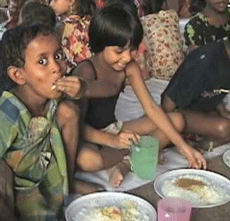Nearly 22% of Indians live in poverty: Plan panel
24 Jul 2013
The ratio of persons below the poverty line in India in 2011-12 has been estimated at an average 21.9 per cent with the percentage of the poor higher at 25.7 per cent in rural areas and lower at 13.7 per cent in urban areas.
 The number of people below poverty line in India in 2011-12 stood at 270 million according to estimates based on the Tendulkar Poverty Line, as compared to 407 million in 2004-05, a reduction of 137 million persons over the seven-year period, figures released by the Planning Commission today showed.
The number of people below poverty line in India in 2011-12 stood at 270 million according to estimates based on the Tendulkar Poverty Line, as compared to 407 million in 2004-05, a reduction of 137 million persons over the seven-year period, figures released by the Planning Commission today showed.
The respective all-India ratio of people below poverty line stood at 37.2 per cent, while their ratios for the rural and urban areas were 41.8 per cent and 25.7 per cent, respectively in 2004-05.
The percentage of people below the poverty line in the country in 1993-94 stood at 45.3 per cent, with around 50.1 per cent in rural areas and 31.8 per cent living in urban areas.
During the 11-year period between 1993-94 and 2004-05 the average decline in the poverty ratio was 0.74 percentage points per year. It accelerated by about three times to 2.18 per cent per year during the 7-year period 2004-05 to 2011-12, the Planning Commission claims in its Poverty Estimates.
Although the Tendulkar committee's poverty line estimate is being reviewed and may be raised by the Rangarajan Committee, the Planning Commission feels it would not change the trend of declining poverty in the country.
However, the absolute levels of poverty would be higher, the rate of decline would also be higher, the plan panel points out.
According to the Planning Commission, there has been an increase in real per capita consumption, resulting in a decline in poverty.
While the monthly per capita expenditure (MPCE) increased for each of the ten deciles, the increase in the second period (2004-05 to 2011-12) was much higher compared to the first (1993-94 to 2004-05).
Also, the increase was fairly well distributed across all deciles of the population, and the distribution was particularly equitable in rural areas.
The estimates tabulated by the National Sample Survey Organisation (NSSO) is based on expenditure samples of about 12 million households. Since these households have different number of members, the NSSO has divided the household expenditure by the number of members to arrive at per capita consumption expenditure per month.
For 2011-12, for rural areas the national poverty line using the Tendulkar methodology is estimated at Rs816 per capita per month and Rs1,000 per capita per month in urban areas.
Thus, for a family of five, the all-India poverty line in terms of consumption expenditure would amount to about Rs4,080 per month in rural areas and Rs5,000 per month in urban areas. These poverty lines would vary from state to state because of inter-state price differentials.
Meanwhile, the Rangarajan Committee is deliberating on the ways of revising the Tendulkar formula for poverty estimates and is expected to submit its report by the middle of 2014.
The Tendulkar methodology uses implicit prices derived from quantity and value data collected in household consumer expenditure surveys for computing and updating the poverty lines.
Since data from the NSS 68th round (2011-12) of household consumer expenditure survey is now available, and the Rangarajan Committee's recommendation will only be available a year later, the Planning Commission has updated the poverty estimates for the year 2011-12 as per the methodology recommended by Tendulkar Committee, the government release added.

.webp)


.webp)


























